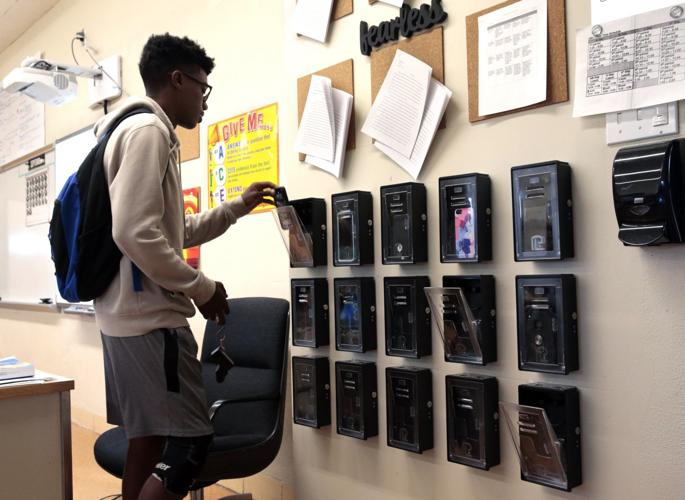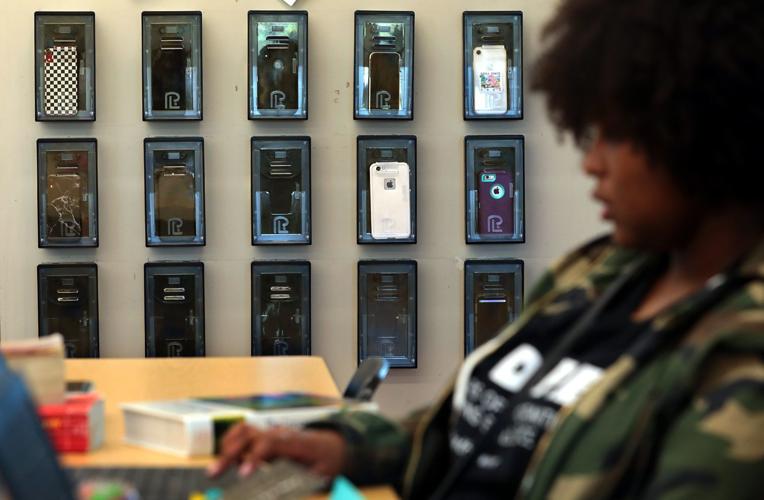UNIVERSITY CITY ŌĆö High school art teacher Bill Henricks says cellphones have caused the biggest disruption in classrooms in his 24 years in education.
His students at Hazelwood East High School could not stop looking at their phones, even if they were in their backpacks or pockets. The lure of the beep or the buzz was too strong.
In 2017, Henricks taped a box to each of the seven tables in his classroom for students to put away their phones during class time.
ŌĆ£If they cannot touch their phone, they donŌĆÖt think about it that much,ŌĆØ Henricks said. After a year and a half of using the boxes, studentsŌĆÖ grades went up, and discipline actions went down. ŌĆ£My students did a 180. I had their attention.ŌĆØ
Along with two engineers, Henricks started a company and developed a more high-tech version of his box. This fall, University City High School became the first school to purchase and install the Phone Locker.
People are also reading…
About 80% of U.S. schools have some type of cellphone policy, according to a national survey of 1,200 teachers released earlier this year by the nonprofit Common Sense Media. But as more students carry their own phones, the percentage of school districts with total bans has dropped from more than 90% in 2010 to about 66% in 2016, according to the National Center for Education Statistics.
Cellphone policies have been a ŌĆ£work in progress,ŌĆØ said Trisha Crenshaw, associate principal for student affairs at Nerinx Hall. This year, the all-girls Catholic high school loosened its rules when it found students were sneaking onto their phones in class under a total ban during school hours. TeachersŌĆÖ class time increasingly was spent scolding students caught with their phones.
Now students can use their phones before school, after school, in a 9:40 to 10:15 a.m. activity time and in the cafeteria during lunch.
There have been fewer detentions this year because of cellphone violations, Crenshaw said. Students have been happier with the increased access to phones.
ŌĆ£We want to protect the academic time but also have balance,ŌĆØ she said.
Playing cards
Aside from the discipline issue, cellphone rules have been in flux because parents want to be able to contact their children at all times. School officials donŌĆÖt want to be held liable for confiscated phones. And some classes have incorporated phone apps into their lessons, like making movies or tracking homework.
A decadelong ban on cellphones was lifted in 2015 for New York CityŌĆÖs 1.1 million public school students. The ban had been unevenly enforced, with punishment more likely for students in schools with metal detectors. Now principals can determine their own policies.
Still, some schools are moving the other way. In the last few years, middle schools in Highland and Collinsville banned cellphone use on campus. The U46 School District in ChicagoŌĆÖs northwest suburbs instituted a ban on cellphones this year and installed $15 phone holders in 1,000 classrooms.
Under a new rule this year at Westminster Christian Academy in Town and Country, students are allowed to carry phones but cannot turn them on during school hours.
Barrett Mosbacker, WestminsterŌĆÖs head of school, said the difficulty in enforcing a cellphone ban should not be a reason to drop it.
There were three reasons for enacting the new ban, Mosbacker said ŌĆö to encourage deep thinking in classrooms with minimal distractions, to promote personal connections and to help students develop healthy relationships with technology.
The response has been overwhelmingly positive, at least from teachers and parents, Mosbacker said. Students are less enthralled with the ban, he said, but understand the benefits.
ŌĆ£When I walk in the cafe now, theyŌĆÖre talking, laughing, playing cards and board games,ŌĆØ Mosbacker said. ŌĆ£The entire school culture has been elevated and is much more positive.ŌĆØ
As more schools outfit their students with laptops or tablets, the academic argument for cellphones in class has weakened. Research showed college students whose cellphones were taken away performed better on a test compared to those who could use or keep their cellphones, according to a 2017 study in the journal Applied Cognitive Psychology. Another study found that overall cellphone use, not just while in school, corresponded to lower grade-point averages.
Reduced distractions
Before the lockers were installed at University City High, cellphone use in class was the leading complaint from teachers. This year, student discipline referrals by mid-September dropped to 29 from 188.
The University City School District paid HenricksŌĆÖ company Jordiam LLC $40,000 to install 250 devices in 13 classrooms. The money came from a $400,000 federal grant to the high school to improve academic outcomes. The school also will collect data to try to determine whether the lockers make a difference on test scores and grades. English and math classrooms were prioritized, because those subjects are part of most standardized tests. If the pilot project is successful, the school hopes to expand the lockers to every classroom.
English teacher Christina Sneed said that before the lockers, she tried to collect studentsŌĆÖ phones in a desk drawer during class. But students worried the phones would get cracked, mixed up or stolen and often wouldnŌĆÖt turn them in.
ŌĆ£Last year it was a tug of war, a power struggle with students who arenŌĆÖt able to regulate their actions,ŌĆØ Sneed said.
Now, Sneed can control the individual lockers by remote control. Students know their phones are safe, and theyŌĆÖre better able to concentrate, she said.
Tiffanie Thomas, whose son is a sophomore at University City High, bought him an iPhone this year so they could stay in touch about after-school activities. Her main concern with the phone was about the potential distraction in class.
ŌĆ£HeŌĆÖs an easily distracted kid, and with the cell phone locker I really think itŌĆÖs helping,ŌĆØ she said.
Principal Mike Peoples said he also hopes the cellphone lockers help students develop their ŌĆ£soft skillsŌĆØ ŌĆö making eye contact, and having face to face conversations and meaningful interactions with other students and staff.
Last year, sophomore Victoria Trice perked up every time she heard her phone vibrate in her backpack. The cellphone lockers have helped break that automatic response, she said.
ŌĆ£Now I donŌĆÖt know if I get any alerts, so I just focus on my work.ŌĆØ












